Tonewood’s impact on the sound of an acoustic guitar is undeniable. Especially the top material has a huge impact on the tone of an acoustic guitar…
And this is why choosing the right wood species, especially the top wood, is really important. This might sound like a tough task…but no worries! This article makes selecting the right woods a lot easier. This is the guide I wish I had when I bought my first acoustic guitar. So let’s quit the chit-chat and get to the chase!
If you are wondering whether a laminate wood acoustic or solid wood acoustic guitar is the right choice for you, check our full laminate vs solid woods guide here.
Check our electric guitar tonewood guide here.
Different Acoustic Guitar Tonewoods
Acoustic Guitar wood Chart
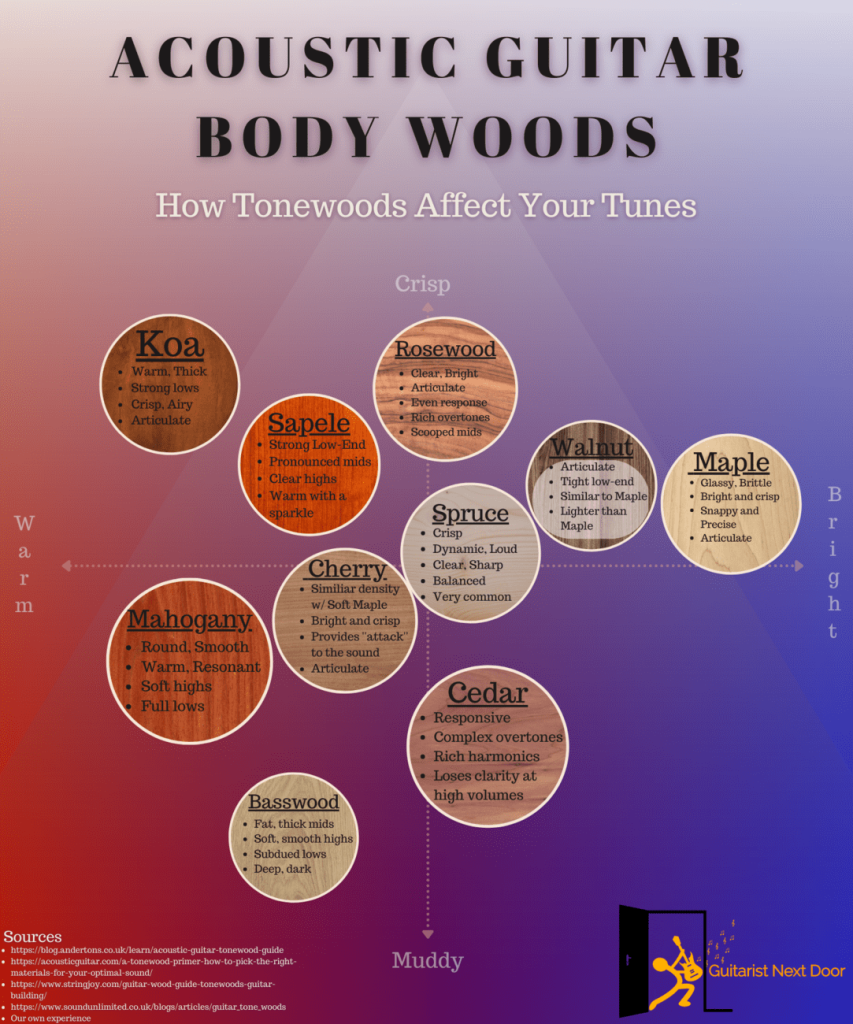
The above image highlights how the tonewoods of acoustic guitars should affect the tone based on wood density, other wood characteristics, and guitar player’s and luthier’s experiences we have gathered. It can direct you in the right direction when choosing the woods for your guitar and it also looks cool!
Acoustic Guitar woods Density Chart (denser the wood is, heavier it is):
| Wood | Density (103 kg/m3) | (lb/ft3) | Janka Hardness Score (lbf) |
|---|---|---|---|
| Basswood | 0.3 – 0.6 | 20 – 37 | 410 |
| Cedar | 0.38 | 23 | 600 |
| Cherry | 0.63 | 43- 56 | 950 |
| Koa | 0.6 | 37 | 2160 |
| Mahogany | 0.5-0.6 | 31 – 37 | 800-860 |
| Maple | 0.6 – 0.75 | 39 – 47 | Soft Maple: 950 Hard Maple: 1450 |
| Rosewood | 0.82-0.9 | 50-55 | 1650-2200 |
| Sapele | 0.64 | 40 | 1410 |
| Spruce | 0.4-0.5 | 25 – 30 | 510 |
| Walnut | 0.65 – 0.7 | 40 – 43 | 1010-1080 |
Let’s now look closer at each wood type!
Check our other in-depth guitar guides too:
Acoustic Guitar Body Types & Styles – Explained
Different Guitar Bridge Types – Your Ultimate Bridge Guide
Guitar Neck Shape Guide – Shapes Explained
4 Types of Acoustic Guitar Pickups – Which One You Should Choose?
Basswood
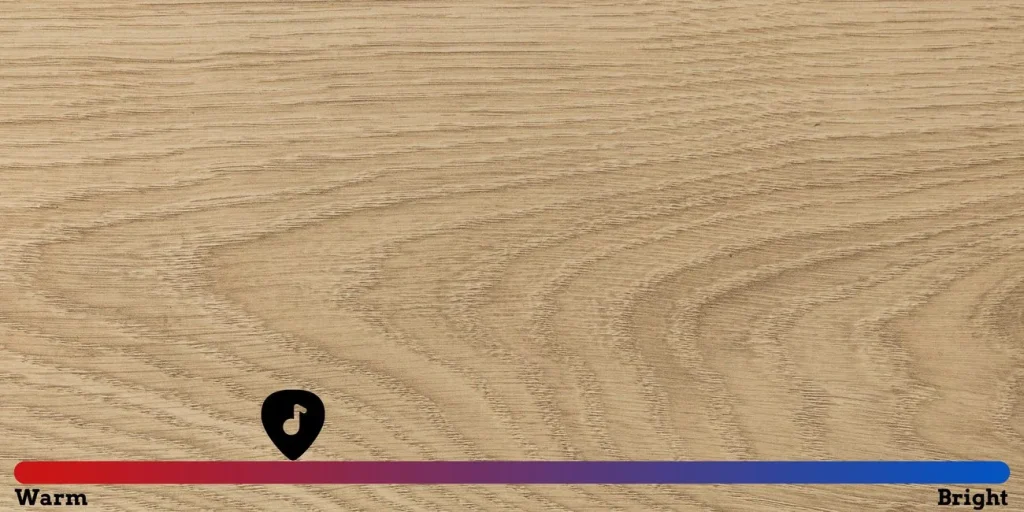
Density :
| (103 kg/m3) | (lb/ft3) | Janka Hardness Score (lbf) |
| 0.3 – 0.6 | 20 – 37 | 410 |
Availability of Basswood: Great
Basswood has mainly straight grains and is a very light and soft wood. Because of these qualities, it’s very easy to work with and a really popular wood, especially on budget acoustic guitars. Basswood produces a very full(fat) and deep sound and can smoothen the bright tones.
Basswood has a reputation of cheap guitar body wood, and with acoustic guitar, it’s usually only used in cheap models. And it’s true that basswood can sometimes dampen the tone too much.
With electric guitars, basswood is used in many higher-priced instruments too, such as EVH and Music Man guitars.
Acoustic guitar brands that use Basswood frequently:
- Gretsch
- Luna
- Harley Benton
- Startone
Basswood is a great option if you want a full and balanced tone that offers great low-end and smoothens bright tones a bit.

Cedar
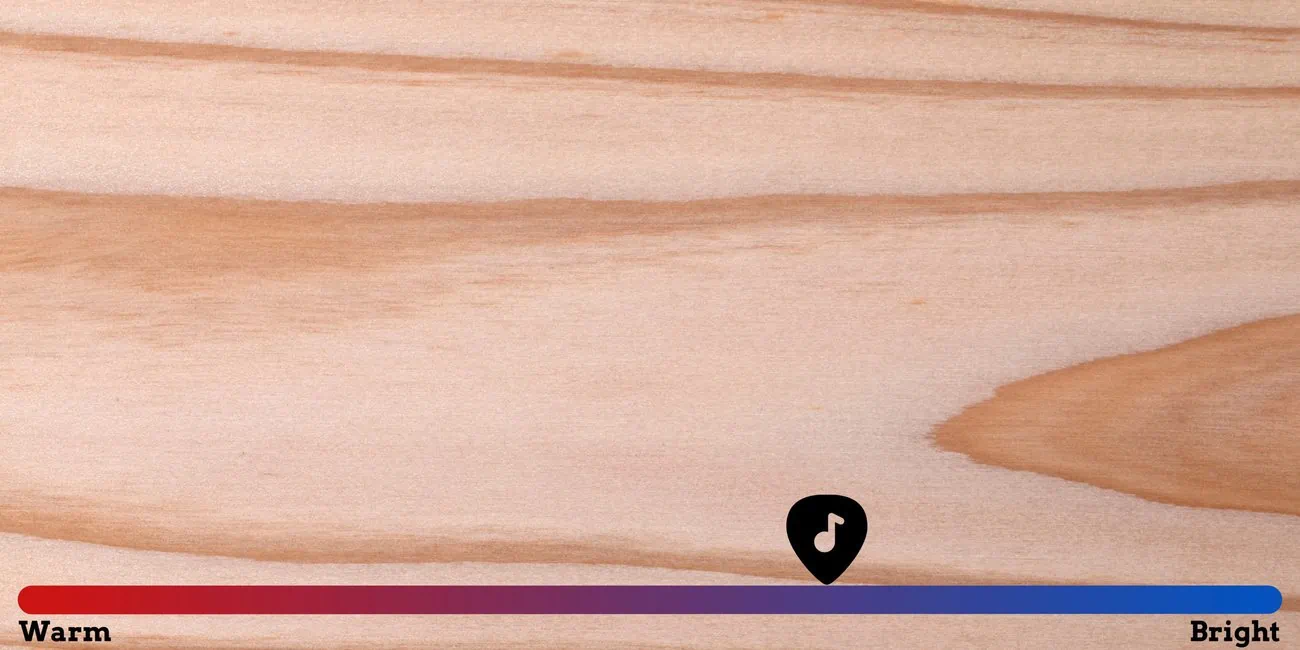
Density :
| (103 kg/m3) | (lb/ft3) | Janka Hardness Score (lbf) |
| 0.38 | 23 | 600 |
Availability of Cedar: Great
Cedar is just slightly less dense than the most common top wood spruce, and it provides a relatively similar tone. Cedar is lightweight and easy to work with. It’s not a super-strong wood but is durable and stable wood after drying. Cedar has pretty straight grains. Western Red Cedar is a popular variety for guitar tonewood due to the broad range of harmonics it provides.
Cedar is mainly used as a top wood. It’s really responsive tonewood that provides rich harmonics and sounds full when not played with much force. It’s quieter than most other tonewoods and can lose clarity when played with force. Brands that frequently use Cedar:
Cedar is a great tonewood if you are after responsive guitar that offers great all-around sound with rich harmonics.

Cherry
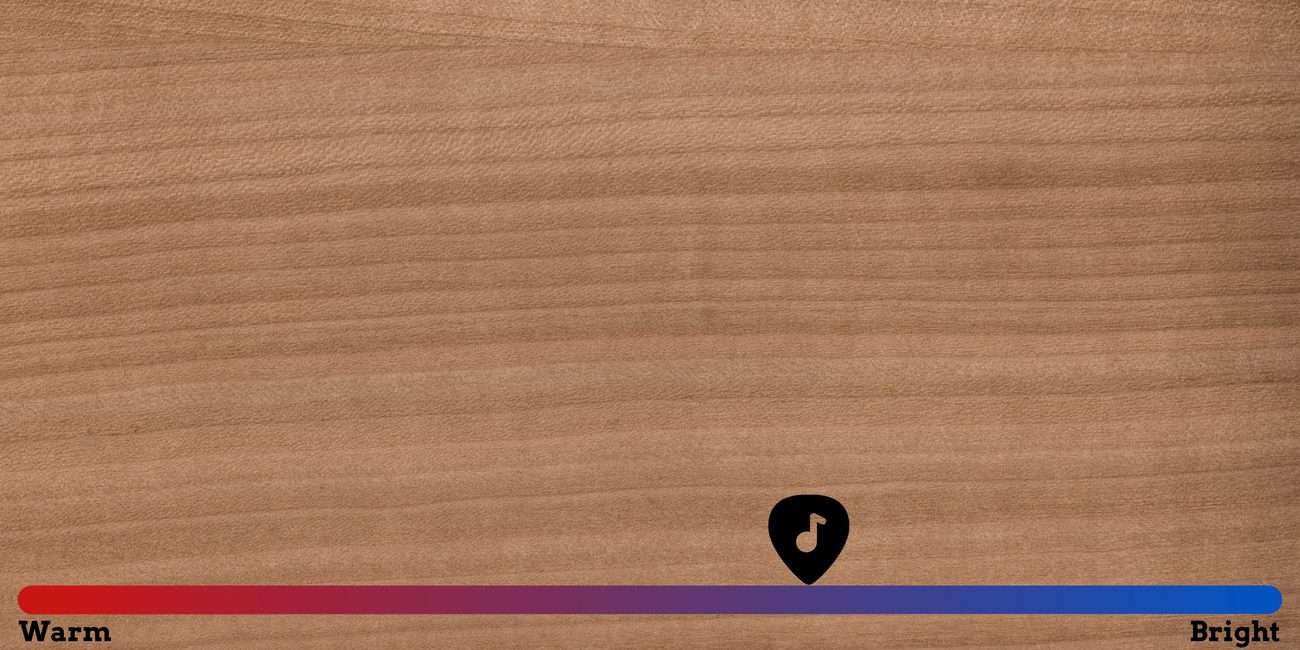
Density :
| (103 kg/m3) | (lb/ft3) | Janka Hardness Score (lbf) |
| 0.63 | 43- 56 | 950 |
Availability of Cherry: Great
Cherry is relatively light wood and its grains are usually straight but can have light waves. It’s easy to work with wood and looks stunning on guitars.
Cherry is usually used on the back & sides of acoustic guitars. Cherry provides a crisp, bright, and articulate tone. Also, cherry can provide some “attack” and “punch” to the sound of a guitar. Brands that frequently use Cherry:
- Godin
- Martin
- Seagull
Cherry is a good option if you want similar tonal qualities to maple but are after something a bit crispier.

Koa
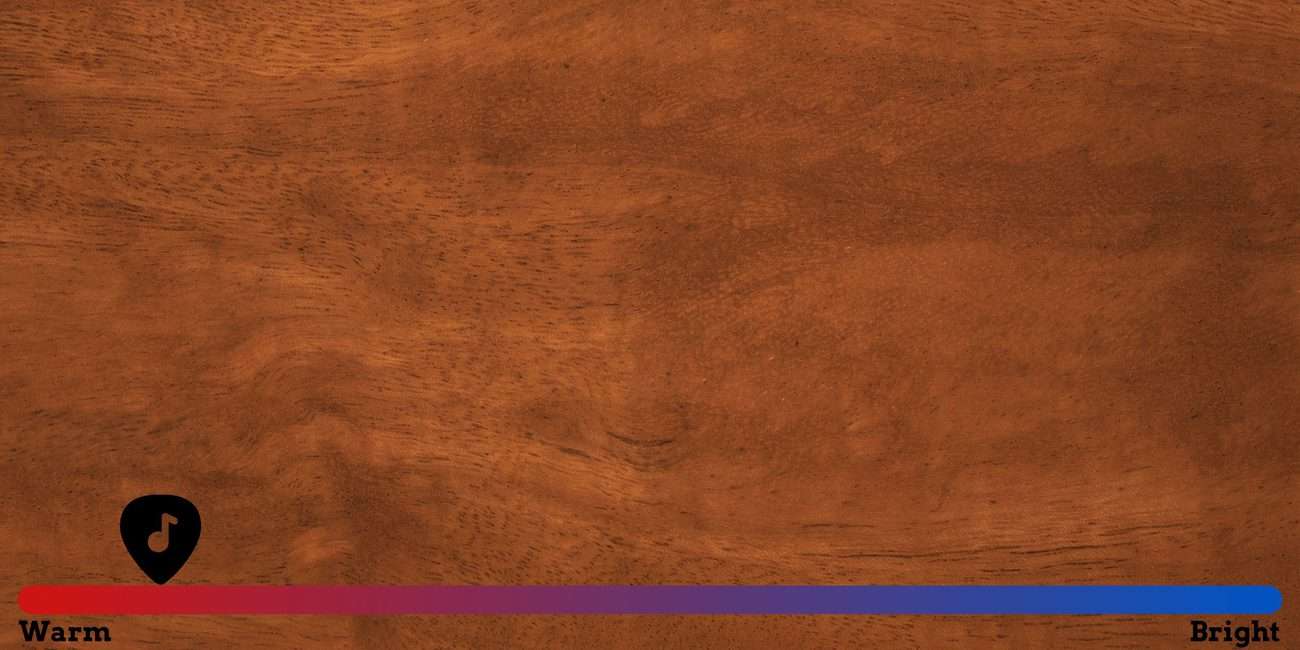
Density :
| (103 kg/m3) | (lb/ft3) | Janka Hardness Score (lbf) |
| 0.6 | 37 | 2 160 |
Availability of Koa: Limited
Grains of koa are usually really close to each other and wavy. Koa is usually easy to work with, but if grains are heavily interlocked some problems can arise. Koa is lightweight and softer than most pieces of ash, maple, and alder. The sound koa produces is really full and articulate, with warm tones and strong lows.
These brands use koa on their acoustic guitars frequently:
- Taylor
- Takamine
- Martin
- Ovation
- Washburn
- Luna
- Breedlove
Koa is a great option if you want stunning “wood”-looks, full and articulate sound, and both warmness and brightness.

Mahogany

Density :
| (103 kg/m3) | (lb/ft3) | Janka Hardness Score (lbf) |
| 0.5-0.6 | 31 – 37 | 800-860 |
Availability of Mahogany: OK
Grains of mahogany are straight and can be interlocked. Mahogany is usually very easy to work with, but interlocking of the grains can cause issues. The mahogany used in guitars is usually a soft wood that provides warm, deep, and round sound with smooth highs.
Different types of mahogany used in acoustic guitars:
- African mahogany
- Central-American mahogany (Honduran mahogany & Cuban mahogany)
Mahogany is more common as a back & sides than as a top wood(tho it’s pretty common as a top wood too nowadays). Brands that use mahogany in their acoustic guitars frequently:
- Taylor
- Breedlove
- Martin
- Fender
- Guild
- Luna
- Yamaha
- Cordoba
- D’Angelico
- PRS
Mahogany is a great wood option if you are after soft wood that offers round, warm, and full sound.

Okoume – Cheaper Alternative to Mahogany
Okoume is a soft hardwood with straight grains and is used in budget-level acoustic guitars. It provides really similar sound to mahogany. Brands using okoume frequently:
Maple

Density :
| (103 kg/m3) | (lb/ft3) | Janka Hardness Score (lbf) |
| 0.6 – 0.75 | 39 – 47 | Soft Maple: 950 Hard Maple: 1450 |
Availability of Maple: Great
Grains of maple are usually straight but can have waves. Usually easy to work with, hard maple being more difficult than soft maple species. Maple is a dense wood that provides bright, crisp, and even glassy sound.
Different types of maple used in acoustic guitars:
- Silver maple
- Soft maple
- Hard maple
- Spalted maple (type of maple that has been allowed to begin initial stages of decay)
- Curly maple (often used for acoustic guitar necks)
Maple is used in many acoustic guitars due to its great availability. Brands that use maple in their acoustic guitars frequently:
- Taylor
- Ibanez
- Gibson
- Ovation
- Traveler
- Fender
- Luna
- Washburn
- ESP
Maple is a great wood option if you are after a bright, crisp, and glassy sound.

Rosewood
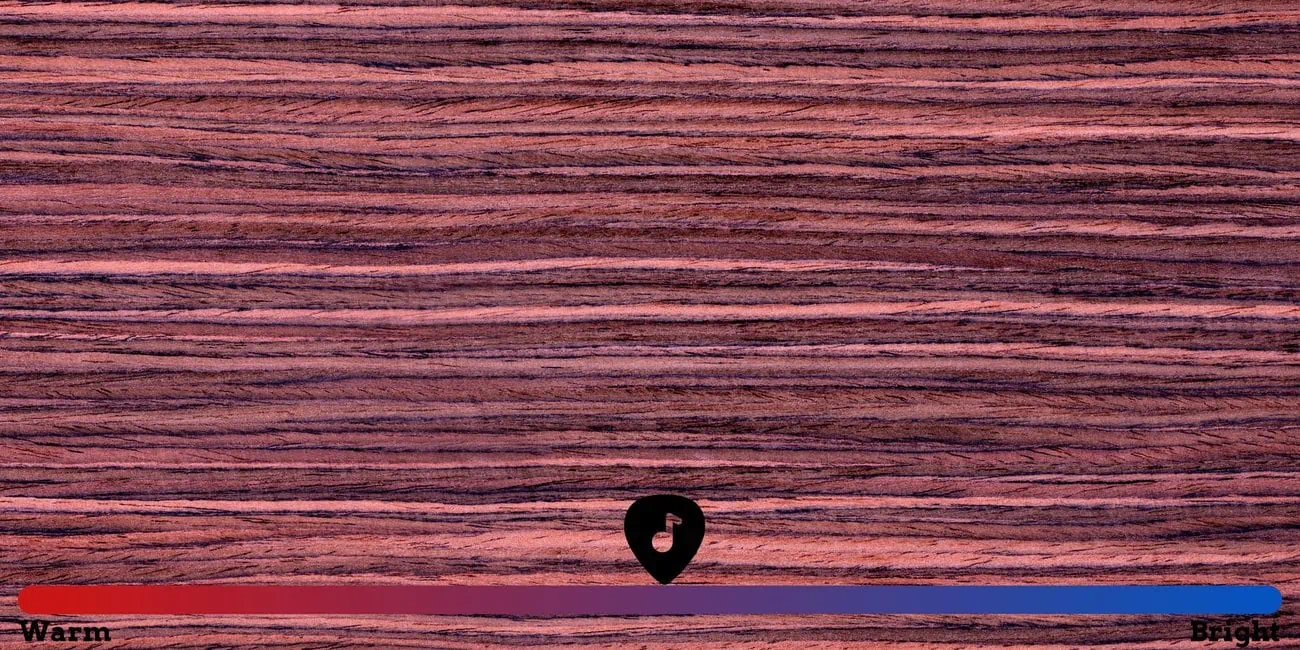
Density :
| (103 kg/m3) | (lb/ft3) | Janka Hardness Score (lbf) |
| 0.82-0.9 | 50-55 | 1650-2200 |
Availability of Rosewood: Good
Rosewood has straight grains that can be slightly interlocked. Rosewood is really dense wood, and can be hard to work with (mainly because of interlocked grains).
Different types of rosewood used in acoustic guitars:
- Brazilian Rosewood
- Indian Rosewood
- East Indian Rosewood
Rosewood is mostly used as a neck and back & sides wood for acoustic guitars. As a hard wood, rosewood offers really articulate, clear, hard, and bright tone. Mids are scooped a bit and the low end is not super bunchy, but the overall good articulation makes up for that. You should note that if you are a heavy strummer, rosewood can make your sound lose articulation when played really hard.
Here are some brands that use rosewood in their acoustic guitars frequently:
- Martin
- Yamaha
- Taylor
- Gibson
- Cordoba
- Breedlove
- Guild
- Takamine
Rosewood is a great option if you want to achieve great articulation and bright & crisp tone.

Sapele
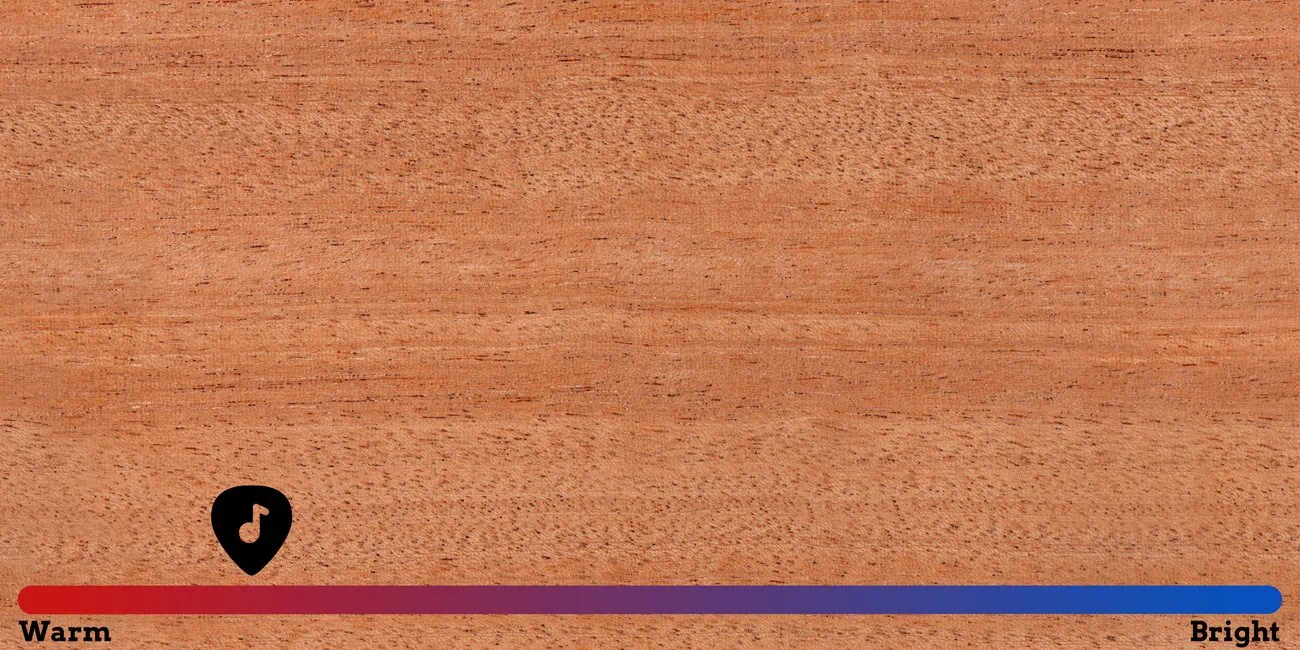
Density :
| (103 kg/m3) | (lb/ft3) | Janka Hardness Score (lbf) |
| 0.64 | 40 | 1410 |
Availability of Sapele: Good
Sapele has interlocked grains that can be wavy. The interlocking of the grains can cause some trouble with workability, especially when operating with electric tools. Sapele is a hard wood, but it generates surprisingly punchy and strong low-end with pronounced mids and clear highs.
Sapele is mostly used as a top wood, but it’s not very common. Here are some brands that use Sapele in their acoustic guitars frequently:
- Martin
- Ibanez
- Takamine
Sapele is a great choice if you want to achieve strong performance with pretty much every frequency, highs, mids, and lows. The sound has a spark in it, but it’s not as bright and crisp as maple and rosewood tops.

Spruce
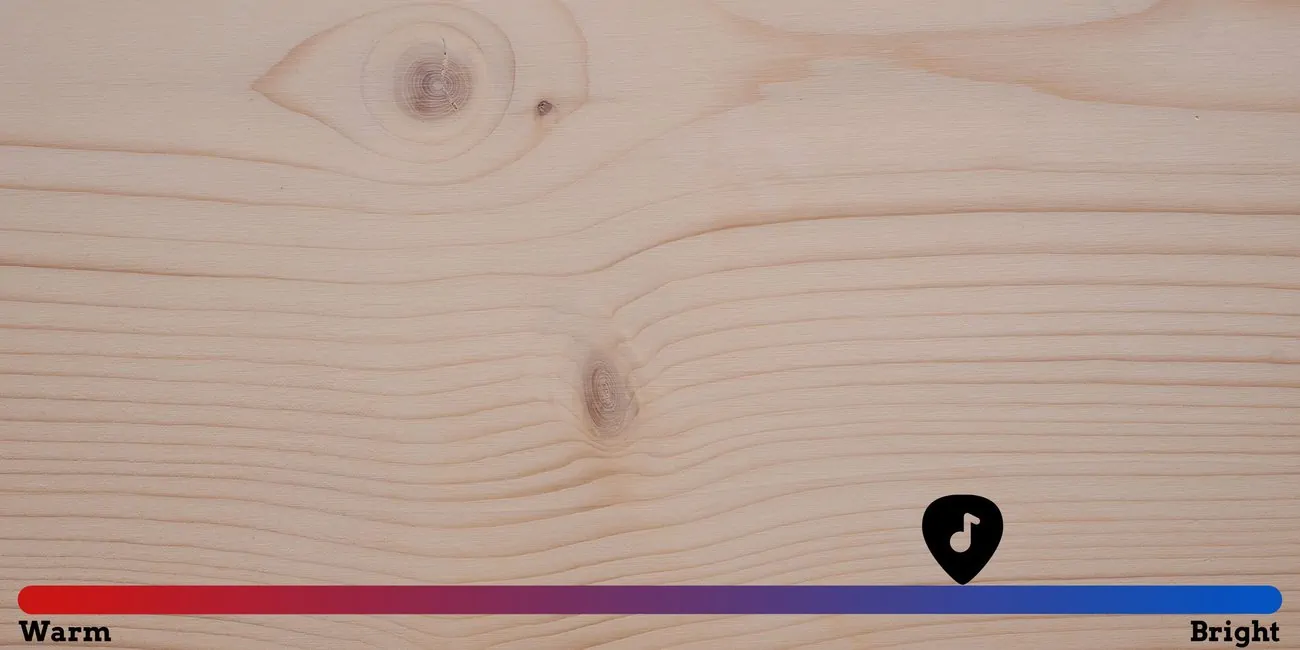
Density :
| (103 kg/m3) | (lb/ft3) | Janka Hardness Score (lbf) |
| 0.4-0.5 | 25-30 | 510 |
Availability of Spruce: Great
Spruce is by far the most common top wood of acoustic guitars. Spruce is a strong wood for its weight and has straight grains. Spruce is known for its excellent sound resonance and that’s why it’s commonly used in pianos, violins, and guitars.
Popular varieties of Spruce for acoustic guitar tone wood:
- Sitka Spruce
- Red Spruce
- European Spruce (popular with Taylor Guitar)
- German Spruce
- Adirondack Spruce
- Lutz Spruce
Spruce is easy to work with, durable, and has great availability, all this only increases its popularity.
As a tonewood, spruce is really versatile. It’s dynamic, balanced, bright, and crisp with great volume and projection. Brands that use spruce in their acoustic guitars frequently:
- Yamaha
- Taylor
- Martin
- Gibson
- Guild
- Takamine
- Cordoba
- Fender
- Ovation
- Ibanez
- Breedlove
- Epiphone
- Washburn
Spruce is an excellent choice if you are after versatility and great projection with balanced, crisp, and dynamic tones. Plus, acoustic guitars with a spruce top are super easy to find.

Walnut

Density :
| (103 kg/m3) | (lb/ft3) | Janka Hardness Score (lbf) |
| 0.65 – 0.7 | 40 – 43 | 1010-1080 |
Grains of walnut are usually straight, but there can be irregular patterns. Walnut is easy to work with most of the time, but irregular patterns of grains can sometimes cause tearing. Walnut provides some similar tonal characteristics to ash species. The sound is articulate, smooth, and bright with a tight low end.
Walnut species usually used in guitars are:
Walnut is usually used on the back & sides of acoustic guitars. Brands that use walnut frequently:
- Gibson
- Taylor
- Takamine
- Yamaha
- Washburn
- Martin
Walnut offers an overall bright and smooth sound with a tight low-end and good articulation.

Blackwood
Density :
| (103 kg/m3) | (lb/ft3) | Janka Hardness Score (lbf) |
| 0.64 | 40 | 116 |
The grains of blackwood as usually straight with some slight interlocking with a fine to medium texture. There are marked similarities in color between Australian Blackwood and Koa or Mahogany, while African Blackwood is very dark. The most sought after Blackwood is grown in Tasmania.
Blackwood species usually used in guitars are:
- Australian Blackwood (Acacia melanoxylon)
- African Blackwood
- Malaysian Blackwood
Australian Blackwood is used throughout acoustic guitars bodies, while African Blackwood is a great fretboard wood. Brands that use Blackwood frequently:
- Breedlove
- Taylor
- Cort
- Blackwood Guitar Company
- Maestro Guitars
Blackwood offers a sweet sound that matures well. With a clear top end and a rich mid-range, this wood is well regarded amongst the best acoustic guitar companies.

Best Wood for Acoustic Guitar?
There’s no such thing as the best wood for acoustic guitar. But there are excellent wood options for specific situations and purposes. Here are a couple of great woods for different situations:
- Maple = If you are after great articulation and want to hear every aspect of the playing with great definition.
- Mahogany = Great for heavy strumming, offers loudness, projection, and articulation without losing definition.
- Rosewood & koa = Great if you are after fingerstyle acoustic guitar that offers clear highs.
Remember this: Storing your guitar in an enviroment that has humidity suitable for a guitar is really important for acoustic guitars. Wrong levels of humidity can affect the guitars sound or even crack the tonewoods.
FAQ
Do Tonewoods Matter on Acoustic Guitar?
Yes. Tonewoods matter on acoustic guitars. The vibration (sound) of the strings transfers to body woods (tonewoods) through saddles and bridge. How dense the woods are, how heavy & thick they are, and in some cases how old they are, has an impact on the overall vibration and sound.
This image explains more:

- You strum the strings.
- Strings vibrate
- Vibration is transferred to the body woods through the saddles and bridge.
- All parts vibrating & resonating push the air and the air inside the sound chamber is compressed heavily and pushed out through the sound hole. All this creates the sound of acoustic guitar.
And in all this, the level of vibration and resonance of the body woods used impact the sound of acoustic guitar.
What Part of Guitar is Tonewood?
With acoustic guitars, tonewoods are considered to be:
- Top
- Back
- Sides
- Neck (some people leave this out from tonewoods)
- Fretboard (not that often)
Learn more about acoustic guitar anatomy here.
What is Top Wood on Guitar?
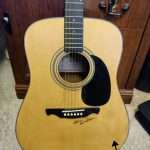
The top is also known as a soundboard. It’s a piece of wood at the top of the guitar where the bridge, pickguard, and soundhole are located (usually).
What Are The Best Acoustic Guitar Tonewoods for Vocalists and Singers?
Again, there’s no such thing that the best acoustic guitar tonewood for every singer.
If you want to achieve a boomy and loud tone with a strong low-end that supports your singing, dreadnoughts and jumbo acoustics with Mahogany and Sapele tonewoods work great.
If you want stronger mids and clearer highs, smaller guitars with Spruce, Rosewood, or Cherry can work great.
If you want that everyone can hear all of the tonal aspects of your acoustic guitar with great articulation, Maple is the best choice.
What Kind of Woods Are Acoustic Guitars Made From?
I gathered most of the woods used in acoustic guitars here:
Acoustic Guitar Fretboard Woods
- Ebony
- Rosewood
- Walnut
- Ovangkol
- Pau Ferro
- Richlite
- Laurel
- Eucalyptus
- Harwood (usually a mix of leftover woods)
Acoustic Guitar Neck Woods
- Mahogany
- Hardwood (usually a mix of leftover woods)
- Nato
- Maple
- Nyatoh
- Rosewood
- Sapele
- Birch
Acoustic Guitar Back & Side Woods
- Mahogany
- Rosewood
- Sapele
- Maple
- Walnut
- Lyrachord
- Koa
- Okoume
- High-pressure laminate
- Myrtlewood
- Ovangkol
- Nato
- Basswood
- Cherry
Acoustic Guitar Top Woods
- Spruce
- Mahogany
- Cedar
- Maple
- Koa
- Myrtlewood
- Okoume
- High-pressure laminate
- Sapele
- Carbon fiber (not a wood)
- Basswood
- Redwood
- Agathis
- Ebony
What is The Best Tonewood for Fingerstyle Guitar?
With acoustic guitars, tonewoods are considered to be:
- If you are after rich highs, hard woods such as rosewood, koa, and walnut are great choices.
- If you are after a really articulate sound, maple is the best choice since it provides really precise tones.
- Sides
- Neck (some people leave this out from tonewoods)
- Fretboard (not that often)
What is The Best Tonewood for Strummers and for People Using A Pick?
If you are a heavy strummer, I would stay away from the hardest woods such as Rosewood. Really hard woods can cause the sound to lose its definition when played hard.
Maple starts to be an ok choice, but I recommend testing one before buying, since some maple tonewoods can be harder than others.
But when we move to koa, mahogany, and walnut, which are relatively hard woods, but soft enough to provide great articulation and definition even when played hard without sounding damp.
Cedar, spruce, and basswood are solid options for strummers, but they can lose clarity with high volume.
Does Guitar Neck or Fretboard Wood Affect Tone?
Both neck and the fretboard vibrate and both are connected to the body. This is why they can have a tiny (non-existent) impact on the sound of acoustic guitar. But still, the impact is so small that I wouldn’t pay attention to the neck and fretboard materials when thinking about what kind of sound I’m after.
But when thinking about playability and looks, sure, pay attention to both the neck and fretboard.
Does Bridge, Saddle, or Nut Affect The Tone?
Saddles and nut are in direct contact with the strings so they affect the vibration of the strings too. So we can say that both have an impact on the sound of an acoustic guitar. The impact is probably not huge, but they for sure are only parts besides frets and tuners that come in contact directly with the strings.
Saddles and the bridge deliver the vibration of the strings to the body, so they do play a role in your acoustic guitars overall tone.
Check our favorite acoustic guitars under $500 and the best acoustics under $1000.
Conclusion
Tonewoods of acoustic guitars are a super interesting topic. They have a huge impact on the tone and looks. There are a ton of different options available. And depending on if you want to fingerstyle, sing and play, or just all-around strum your acoustic, choosing the right one for your needs is important. I hope that this article helped you to choose the right tonewoods for you.
If you have any questions, experiences to share, or you spotted a mistake, just comment down below and let’s chat. I wish you all the best and keep rocking!
Teemu

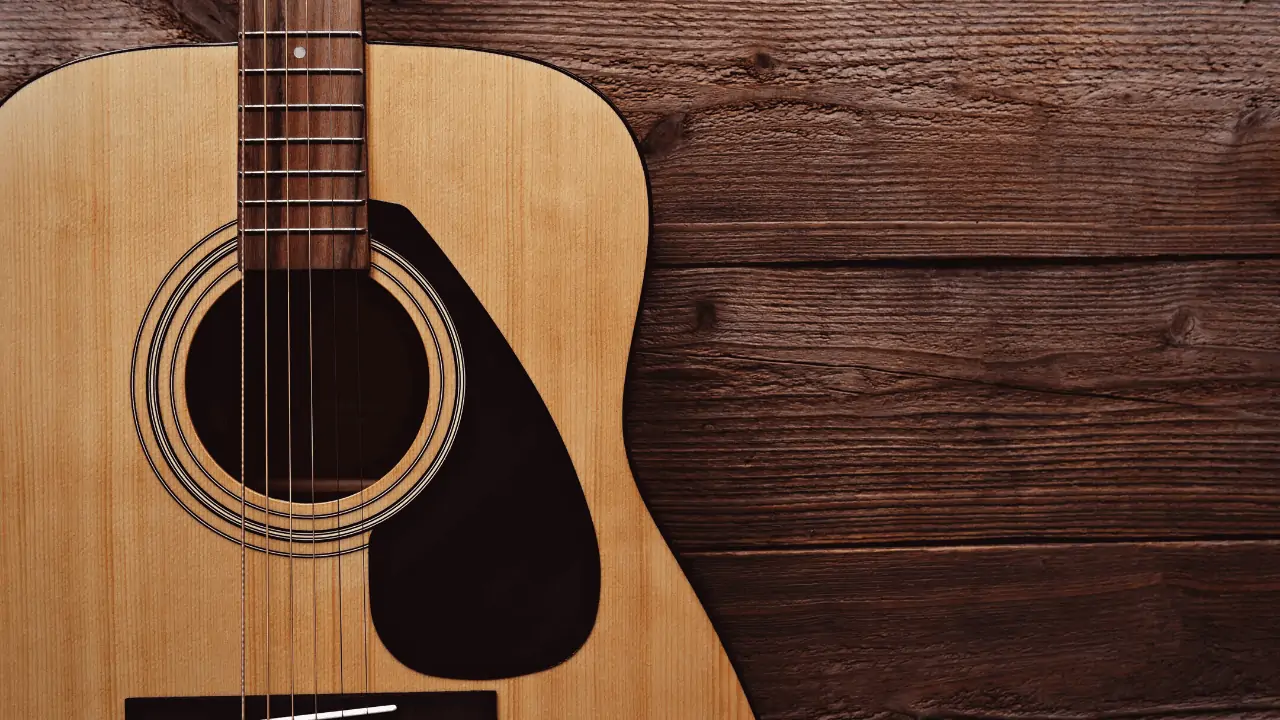



Awesome….admirable work. Thank you…I had spent about 30 minutes typing here with comments…and history notes, towards asking you a couple of questions. My vision impairment worked against me when all of a sudden, everything was erased. What a pitty. I got discouraged and decided to send you a short message in the hope that you read it…and I get a reply.
At any rate, Thank you for your marvelous piece.
From the coffee belt region in my native Colombia, South America….my best to you.
Yaraé
Thank you Yaraé and nice to meet you! Feel free to ask me any questions you want! You can also email me directly at teemu(@)guitaristnextdoor.com! It’s awesome to have you visiting our website. How are things in Colmobia? I bet it’s extremely beautiful out there. Awesome that you like our work and all the best to you and your family!
Teemu